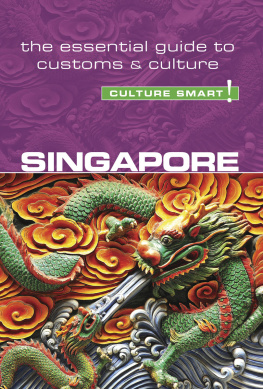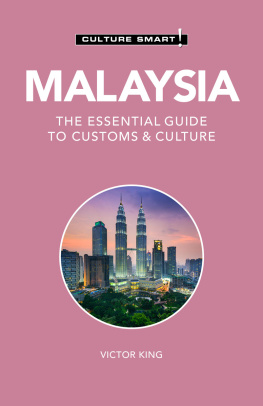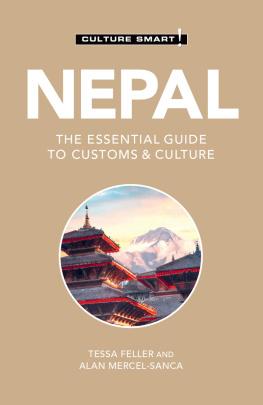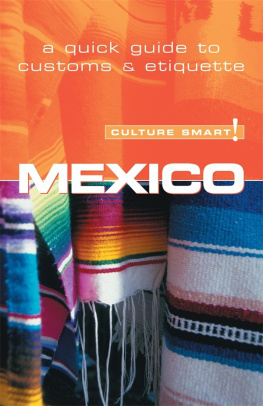
This book is available for special discounts for bulk purchases for sales promotions or premiums. Special editions, including personalized covers, excerpts of existing books, and corporate imprints, can be created in large quantities for special needs.
For more information contact Kuperard publishers at the address below.
ISBN 978 1 85733 887 4
British Library Cataloguing in Publication Data
A CIP catalogue entry for this book is available from the British Library
First published in Great Britain
by Kuperard, an imprint of Bravo Ltd
59 Hutton Grove, London N12 8DS
Tel: +44 (0) 20 8446 2440 Fax: +44 (0) 20 8446 2441
www.culturesmart.co.uk
Inquiries:
Series Editor Geoffrey Chesler
Design Bobby Birchall
Printed in India
Cover image: Dragons, ancient Chinese symbol of strength, authority, and justice, at the Yueh Hai Ching Temple in Raffles Place, Singapore. iStockphoto.
The photographs on are reproduced by permission of the author.
Images on the following pages reproduced under Creative Commons Attribution-Share Alike 4.0 International license: Supreme Dragon, derivative work: Nevetsjc (talk).
Reproduced under Creative Commons Attribution-Share Alike 3.0 Unported license: Smuconlaw.
Creative Commons Attribution-Share Alike 2.5 Generic license: Huaiwei.
Creative Commons Attribution-Share Alike 2.0 Generic license: Michael Elleray from England, United Kingdom.
Creative Commons CC0 1.0 Universal Public Domain Dedication: M L Wong
Images on pages Shutterstock:
About the Author
ANGELA MILLIGAN prepares individuals and families from Europe and North America for expatriate life, an important aspect of which is cultural-awareness training. She has worked in East Asia, Australia, Belgium, and Argentina, and has briefed international companies on Singapore. Her publications include How to Survive in Style, a practical guide for newly arrived expatriates to Britain, and Customs and Etiquette of Australia. Angela is a graduate in History from the University of East Anglia and a fellow of the Royal Society of Arts.
TRICIA VOUTE has a B.A. in Anthropology from Durham University and an M.A. in the Philosophy of Religion from Kings College, London. She has taught philosophy in different parts of the world and written textbooks on the subject, as well as articles on cultural and faith issues in the Times and other publications. Tricia lived in Singapore for five years, teaching religion and philosophy at the Tanglin School. She was involved in teacher training in local schools and has Singaporean friends across the social and religious spectrum.
The Culture Smart! series is continuing to expand. All Culture Smart! guides are available as e-books, and many as audio books.For the latest titles visit
www.culturesmart.co.uk
The publishers would like to thank CultureSmart! Consulting for its help in researching and developing the concept for this series.
CultureSmart! Consulting creates tailor-made seminars and consultancy programs to meet a wide range of corporate, public-sector, and individual needs. Whether delivering courses on multicultural team building in the USA, preparing Chinese engineers for a posting in Europe, training call-center staff in India, or raising the awareness of police forces to the needs of diverse ethnic communities, it provides essential, practical, and powerful skills worldwide to an increasingly international workforce.
For details, visit www.culturesmartconsulting.com
CultureSmart!Consulting and CultureSmart! guides have both contributed to and featured regularly in the weekly travel program Fast Track on BBC World TV.
contents
Map of Singapore

introduction
The small island state of Singapore is unique in the region. Not only is it a young countryindependence came in 1965but it is a land of immigrants, in which people from three distinct backgrounds, Chinese, Malay, and Indian, live side by side in harmony.
This multicultural harmony is no accident. It has been consciously engineered by the government to ensure the racial riots of 1964 are never repeated. Through housing projects, Racial Harmony Day (July 21), and free education for all, social awareness and national pride are propagated. This is a positive, energetic, can do society, whose citizens are often worried about not keeping up with the Joneses, or, as it is portrayed in Singapore, kiasu, from the Hokkien word meaning to miss out.
On August 9, 1965, the national leader Lee Kuan Yew faced the unknown when he announced that Singapore had been forced to leave the newly formed Federation of Malaysia. Many commentators feared the worst; this newly created republic had no natural resources, was tiny compared to its neighbors, and only had its deep water harbor, its commercial skills, and its close proximity to the rest of Asia to rely on. Within fifteen years, however, Singapore had transformed itself into an economic powerhouse and become a byword for technical excellence. Popularly known as the Little Red Dot, it is considered the twentieth centurys most successful development story and exerts an influence on the international stage that far exceeds its size.
Yet despite Singapores Western veneer and expat population, the visitor is quickly reminded that the Lion City is most definitely Asian. Although many of the traditional cultural values of the communities living there have been challenged by the demands of the modern Singaporean state, their underlying philosophies remain intact. It is therefore difficult to talk about a typical Singaporean, for this would depend on whether one were referring to someone of Chinese, Malay, or Indian descent. By and large, however, this is a goal-oriented, meritocratic society. It is also fair to say that the three ethnic groups share certain Asian values in commonbelief in ordered relationships, obligation, respect for traditions, polite behavior, and the protection of face, both for oneself and for others.
Culture Smart! Singapore introduces the Western visitor to the rich and varied cultures and customs of Singapores communities. It shows what motivates people, how they interact with each other and with outsiders, and tells you what to expect and how to behave in unfamiliar situations. It will also draw attention to the rapid social changes that have occurred as a result of globalization. In doing so, it offers you a fuller, more rounded experience of this fascinating society.
Key Facts
Official Name | Republic of Singapore | Singapore is a member of ASEAN. |
Capital | Singapore City | On the southeast coast of the island |
Area | 279 sq miles (722 sq km) | Population density 8,000 per sq km |
Currency | Singapore Dollar |
Climate | Tropical, hot 73-90F (23-32C), humid and rainy all year | There is a monsoon season from November to January. |
Population |
Next page






